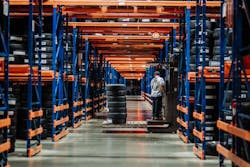This MTD exclusive was provided by John Healy, managing director and research analyst with Northcoast Research Holdings LLC, based in Cleveland, Ohio. Healy covers a variety of subsectors of the automotive industry.
Our recent conversations with tire dealers leave us with a view that retail sell-out trends have improved compared to September of last year, although activity levels did fall compared to what we were hearing in both July and August, when our contacts saw sell-out trends that exceeded 2019 levels.
From a volume standpoint during the month of September, surveyed dealers reported that their unit sales were up from 3% to 8% versus September 2020 levels.
We believe that September - the last month for which we have numbers at the moment - benefited from a rebound in miles driven, which reached a more normalized state. (Miles driven were in a much more depressed state during this timeframe last year.)
Thirty-eight percent of respondents to our latest survey indicated they experienced positive demand year-over-year. This compares to the prior-month level of 47%.
When asked to provide context, dealers said the fall-off was most likely attributable to the unpredictable nature of the auto repair business, as the first half of the third quarter was described as showing nearly record strength in tire demand.
As I’ve mentioned in past columns, we continue to hold the perspective that volumes will become more closely aligned with the current level of GDP growth. We expect more consumers to drive. However, there is still a degree of uncertainty around the COVID-19 pandemic.
Pricing and raws
We also note that tire manufacturers continue to raise prices across many product segments.
While prices have gone up more or less in unison across the manufacturers of all product tiers, we believe that the absolute difference in tire prices is greater than it was during the early days of the pandemic, which is likely weighing on consumers’ minds.
That said, we hold the view that the pricing environment in North America will remain rational and in-line with raw material costs.
Looking more closely at raw material costs, we note that the “basket” of raw materials needed to build a common replacement tire has increased 23.7% on a year-over-year basis, while decreasing slightly - by 0.1% - on a sequential, month-over-month basis.
This continues the trend of rising raw material prices that began at the start of 2020, although year-over-year increases have continued to moderate since the highs we observed this past April.
Holding current spot prices flat would yield a 25.4% year-over-year increase in input costs needed to build a tire.
In assessing pricing movements of individual raw materials, the price of carbon black has increased for the eighth month in a row - with a continued upward trajectory year-over-year.
Crude oil prices, as we have noted previously, experienced severe downard cost pressure at the start of the COVID-19 pandemic.
Average oil prices were down 37% year-over-year from March 2020 through the end of last year.
However, August 2021 saw a year-over-year increase of 59% - although sequential declines in oil prices occurred for the first time since November 2020.
The price of natural rubber increased by 6.4% year-over-year this past August, which is a divergence from the double-digit trends seen since August 2020.
Synthetic rubber prices were up more than 30% on a year-over-year basis - the first time this has happened in 10 years.
Price pressures on tire reinforcement items - like cord and fabric - continue to track negative year-over-year at a low- to mid-single-digit rate.
A word about delta
We have observed throughout the pandemic that tire buyers seem to change their preference for certain products and brands based on what’s happening with COVID-19 at the moment.
Our latest survey reveals that tier-two products are in favor among consumers. And tier-three tires are growing in preference.
We also believe that the delta variant of the coronavirus has done little to change driving patterns. This could translate into more demand for passenger and light truck tires in the near term.
We are also pleased to share our view that tire manufacturers continue to remain disciplined in their efforts to manage the trade-offs between volume and price, with the goal of reaching profit targets rather than market share targets.
We are pleased with their disciplined approach to lean production schedules. And global inventories remain relatively lean.
Moreover, both dealers and distributors are continuing to to be tactical with their approach to inventory allocation in the face of a wide range of factors, from tariffs to raw material price increases.
This strategy allows dealers and distributors to successfully direct orders in a way that helps them capitalize on pricing spreads in the market.
About the Author

John Healy
John Healy is a managing director and research analyst with Northcoast Research Holdings LLC, based in Cleveland, Ohio. Healy covers a variety of subsectors of the automotive industry and writes MTD's monthly Your Marketplace column. If you would like to be included in the monthly dealer discussions, contact him at [email protected].
